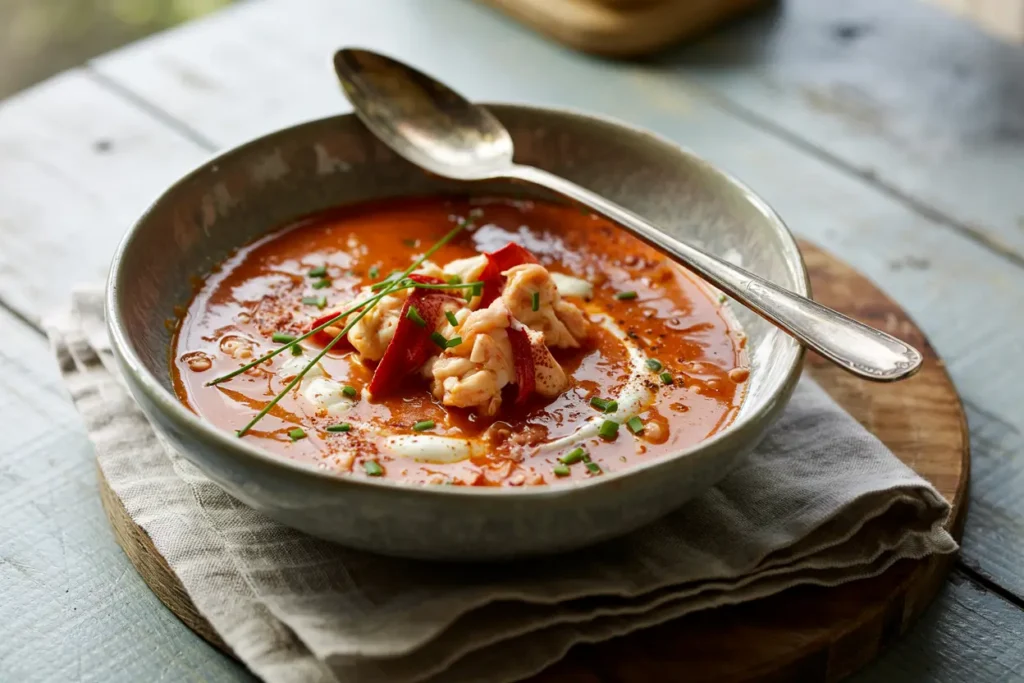Lobster Bisque Recipe: 5 Steps to a Rich, Creamy Bowl
Table of Contents
How to Make Lobster Bisque
Quick Overview
Lobster bisque embodies elegant comfort food — smooth, luxurious, and deeply satisfying, with intricate layers of flavor that reveal themselves with every spoonful. What makes this version special is the careful balance between the sweet brininess of the lobster and the luxurious creaminess of the soup. The foundation of this bisque is a flavorful stock made from the lobster shells themselves, ensuring that no precious flavor is wasted.
Thank you for reading this post, don't forget to subscribe!While lobster bisque has a reputation for being difficult, this streamlined recipe breaks it down into manageable steps that even novice cooks can tackle with confidence. The depth of flavor comes from proper technique rather than complicated ingredients or tools. The entire process takes about 2 hours from start to finish, with much of that being hands-off simmering time. The result is a restaurant-quality bisque that will make any occasion feel special, from an intimate date night to a sophisticated dinner party starter.
The Ingredients I Use to Bring My Lobster Bisque to Life
For the Lobster Stock:
- 2 whole live lobsters (1½ pounds each)
- 2 tablespoons olive oil
- 1 large onion, roughly chopped
- 2 carrots, roughly chopped
- 2 celery stalks, roughly chopped
- 4 cloves garlic, smashed
- 2 tablespoons tomato paste
- ¼ cup brandy or cognac
- ¼ cup dry white wine
- 4 cups seafood stock (or water if unavailable)
- 2 bay leaves
- 3 sprigs fresh thyme
- 10 whole black peppercorns
- 1 teaspoon sea salt
For the Bisque:
- 3 tablespoons unsalted butter
- 1 large shallot, finely diced
- 1 leek (white and light green parts only), cleaned and thinly sliced
- 2 tablespoons all-purpose flour
- 2 tablespoons tomato paste
- ½ teaspoon paprika (preferably sweet Hungarian)
- ¼ teaspoon cayenne pepper (adjust to taste)
- 2 tablespoons brandy or cognac
- 1 cup heavy cream
- Salt and freshly ground black pepper to taste
For Garnish:
- Reserved lobster meat, chopped
- 2 tablespoons fresh chives, finely chopped
- A drizzle of heavy cream
- A tiny pinch of cayenne for color (optional)
Step-by-Step Instructions
Step 1: Prepare the Lobsters
Fill a large pot with enough water to submerge your lobsters and bring it to a rolling boil. Add 2 tablespoons of salt to the water. Carefully lower the live lobsters into the boiling water headfirst. Cover the pot and cook for about 8 minutes – this parboiling technique partially cooks the lobsters, making the meat easier to extract while ensuring the shells will still contribute plenty of flavor to our stock.
Use tongs to lift the lobsters from the water and place them into a large bowl of ice water to halt the cooking. Once they’re cool enough to handle, separate the claws and tails from each lobster. Crack the claws and knuckles with a lobster cracker or the back of a chef’s knife to remove the meat. Slice the tails lengthwise and extract the tail meat. Store all the lobster meat in a covered container in the refrigerator.
Save ALL shells, body parts, and tomalley (the green paste found in the body cavity, which adds tremendous flavor). Rinse the shells quickly to remove any grit.
Step 2: Create a Flavorful Lobster Stock
In a large, heavy-bottomed stock pot, heat the olive oil over medium-high heat. Add all the reserved lobster shells and bodies, then use a wooden spoon to press and crush them into the oil. Cook, stirring occasionally, until the shells turn bright red and you can smell their wonderful aroma, about 5 minutes.
Add the chopped onion, carrots, celery, and garlic to the pot. Cook, stirring occasionally, until the vegetables start to soften, about 5 minutes. Stir in the tomato paste and cook for another 2 minutes, letting it lightly caramelize on the bottom of the pot.
This is where the magic happens – carefully pour in the brandy or cognac to deglaze the pot. If cooking over a gas flame, you can tilt the pot to ignite the alcohol (stand back!), or just let it cook off for about 1 minute. Add the white wine and simmer for 2 minutes more, scraping up any browned bits from the bottom of the pot.
Pour in the seafood stock (or water), then add the bay leaves, thyme, peppercorns, and salt. Bring the mixture to a boil, then reduce the heat to maintain a gentle simmer. Cover partially and let it simmer for 1 hour, allowing all those wonderful flavors to meld.
Strain the stock through a fine-mesh sieve into a clean pot, pressing firmly on the solids to extract maximum flavor. Discard the solids. You should have about 4 cups of rich lobster stock.
Step 3: Create the Bisque Base
In a clean, large pot or Dutch oven, melt the butter over medium heat. Add the diced shallot and sliced leek, cooking until softened but not browned, about 4-5 minutes. Sprinkle the flour over the vegetables and stir constantly for 2 minutes to create a roux, which will help thicken our bisque.
Add the tomato paste, paprika, and cayenne, cooking for another minute until fragrant. Now add the second portion of brandy or cognac, standing back if it flames, and let it reduce for about 30 seconds.
Slowly whisk in the strained lobster stock, making sure the mixture stays smooth and free of lumps. Bring it to a simmer and cook uncovered for about 20 minutes, letting it reduce slightly and deepen in flavor.
Step 4: Blend and Enrich the Bisque
This step is crucial for achieving that signature silky smooth texture. Remove the pot from the heat and use an immersion blender to purée the soup until completely smooth. If you don’t have an immersion blender, carefully transfer the hot liquid in batches to a regular blender, never filling it more than halfway, and holding a kitchen towel over the lid while blending.
Pour the puréed soup back into the pot and heat gently over low heat. Now stir in the heavy cream, warming gently without boiling, which could cause the cream to separate. Taste the bisque and adjust the seasoning with salt and freshly ground black pepper as needed.
Step 5: Finish and Serve with Elegance
Dice the reserved lobster meat into bite-sized pieces. Warm most of the lobster meat gently in a small saucepan with a splash of the bisque (reserving some pieces for garnish). Stir the warmed lobster meat into the bisque just before serving.
Ladle the hot bisque into warmed bowls. Garnish each serving with the reserved pieces of lobster meat, a sprinkle of fresh chives, a delicate swirl of heavy cream, and if desired, a tiny pinch of cayenne for color and a hint of heat.
What to Serve Lobster Bisque With
Lobster bisque is a star on its own, but these accompaniments will create a memorable dining experience:
- Crusty Baguette: A non-negotiable partner—nothing beats sopping up the last drops of bisque with fresh, crusty bread. For an extra touch, serve with herb-infused compound butter.
- Simple Green Salad: The crisp freshness and acidity of a lightly dressed salad with champagne vinaigrette provides the perfect counterpoint to the rich bisque.
- Champagne or Dry White Wine: A glass of Champagne or a crisp Chablis beautifully balances the richness of the bisque while enhancing its flavors. For a non-alcoholic alternative, sparkling water with a splash of lemon offers a refreshing palate cleanser.
- Grilled Seafood: If serving the bisque as a starter, follow with simply grilled fish or scallops that won’t overwhelm the delicate flavors still lingering from the bisque.
- Mini Crab Cakes: For an indulgent seafood feast, serve small crab cakes alongside a cup of bisque as an appetizer course.

Top Tips for Perfecting Lobster Bisque
- Don’t Rush the Stock: The depth of flavor in your bisque depends almost entirely on a well-developed stock. Those 60 minutes of simmering are non-negotiable—in fact, if you have time, you can let it go for up to 90 minutes for even more intensity.
- Strain Thoroughly: For the silkiest texture, consider double-straining your bisque through a fine-mesh sieve. The first time after making the stock, and the second time after blending, even if using an immersion blender.
- Control the Heat with Cream: If your bisque tastes too spicy after adding the cayenne, don’t panic. Adding a touch more cream will help temper the heat while enhancing the luxurious texture.
- Consistency Adjustments: If your bisque seems too thick, thin it with a little more stock or cream. Too thin? Create a slurry with 1 teaspoon cornstarch and 1 tablespoon cold water, then stir it into the simmering bisque until it reaches your desired thickness.
- Alternative Shellfish Options: Can’t find whole lobsters? Substitute lobster tails, or even create a mixed shellfish bisque using shrimp shells and meat along with the lobster. The technique remains the same.
- Make-Ahead Strategy: The bisque actually improves after a day in the refrigerator as the flavors continue to develop. Make it a day ahead through Step 4, then reheat gently and add the cream and lobster meat just before serving.
- Secret Ingredient Option: For an extra dimension of flavor, add a tablespoon of good-quality fish sauce to the stock. It enhances the seafood flavor without making the bisque taste fishy.
Storing and Reheating Tips
Lobster bisque represents a significant investment of time and ingredients, so proper storage is essential to preserve its quality:
Short-term Storage: Let the bisque cool completely before transferring to airtight containers. If possible, store the bisque base (before adding cream) and the cream separately. Refrigerate for up to 3 days.
Freezing Guidelines: For best results, freeze the bisque without the cream or lobster meat. The base freezes beautifully in airtight containers for up to 2 months. Label containers with the date and contents, and leave about an inch of headspace to allow for expansion.
Thawing Process: Thaw frozen bisque overnight in the refrigerator for the safest method. If you’re in a hurry, place the sealed container in a bowl of cold water, changing the water every 30 minutes until thawed.
Reheating for Optimal Flavor:
- Stovetop Method (Preferred): Reheat the bisque gently over low heat, stirring occasionally. If you stored the base without cream, warm it first, then stir in the cream once the base is hot. Never allow the bisque to boil after adding cream, as it may cause separation.
- Microwave Method: If necessary, reheat in the microwave at 50% power in 1-minute intervals, stirring between each interval until warmed through. This gentle approach helps prevent the cream from separating.
Revitalizing Leftover Bisque: If your reheated bisque seems flat, brighten it with a squeeze of fresh lemon juice and a sprinkle of fresh herbs just before serving. If it has thickened too much during storage, thin it with a little warm stock or cream.
Remember that seafood dishes are best enjoyed within a shorter window than other leftovers. For the best experience, consume refrigerated lobster bisque within 2-3 days and never refreeze previously frozen bisque.
With these storage techniques, your luxurious lobster bisque can be enjoyed multiple times, making the effort of preparation even more worthwhile.
click here to follow me on pinterest
Lobster Bisque Recipe: 5 Steps to a Rich, Creamy Bowl
Cuisine: FrenchDifficulty: Advanced4-6
servings30
minutes15
minutes450-600
kcalThis luxurious lobster bisque is a classic French-inspired soup known for its deep, layered flavor and velvety texture. Made from whole live lobsters, aromatic vegetables, a splash of cognac, and rich cream, the bisque is elevated with tender lobster meat and finished with chives and a touch of cayenne for color and gentle heat. It’s an indulgent, restaurant-quality dish perfect for special occasions or entertaining.
Ingredients
2 whole live lobsters (1½ pounds each)
2 tablespoons olive oil
1 large onion, roughly chopped
2 carrots, roughly chopped
2 celery stalks, roughly chopped
4 cloves garlic, smashed
2 tablespoons tomato paste
¼ cup brandy or cognac
¼ cup dry white wine
4 cups seafood stock (or water if unavailable)
2 bay leaves
3 sprigs fresh thyme
10 whole black peppercorns
1 teaspoon sea salt
3 tablespoons unsalted butter
1 large shallot, finely diced
1 leek (white and light green parts only), cleaned and thinly sliced
2 tablespoons all-purpose flour
2 tablespoons tomato paste
½ teaspoon paprika (preferably sweet Hungarian)
¼ teaspoon cayenne pepper (adjust to taste)
2 tablespoons brandy or cognac
1 cup heavy cream
Salt and freshly ground black pepper to taste
Reserved lobster meat, chopped
2 tablespoons fresh chives, finely chopped
A drizzle of heavy cream
A tiny pinch of cayenne for color (optional)
Instructions
- Cook & Clean the Lobsters
Boil live lobsters in salted water for 8 minutes, then chill in ice water. Remove meat from claws and tails; refrigerate. Save all shells, heads, and tomalley for the stock, rinsing to remove grit. - Build the Lobster Stock
Sauté the lobster shells in olive oil until red and fragrant. Add chopped onion, carrot, celery, and garlic; cook until soft. Stir in tomato paste and deglaze with brandy and white wine. Add seafood stock, bay leaves, thyme, peppercorns, and salt. Simmer for 1 hour, then strain and reserve the liquid. - Make the Bisque Base
In a clean pot, cook the shallot and leek in butter until soft. Stir in flour to make a roux, then add tomato paste, paprika, and cayenne. Deglaze again with brandy, then slowly whisk in the strained stock. Simmer for 20 minutes to reduce slightly. - Purée & Enrich
Blend the bisque using an immersion or standard blender until smooth. Return to the pot, stir in heavy cream, and heat gently (do not boil). Season to taste with salt and pepper. - Finish & Serve
Warm chopped lobster meat with a splash of bisque. Stir most into the pot, reserving some for garnish. Serve hot, topped with lobster chunks, chives, a swirl of cream, and a touch of cayenne if desired.
Notes
- Lobster bisque is a labor of love, but the payoff is immense. Roasting or simmering the shells adds an intense seafood depth, while the brandy and wine give it complexity. If using seafood stock, opt for a high-quality version, or make your own from the shells. For a smoother bisque, strain thoroughly and consider blending in batches. This dish shines brightest when served warm with crusty bread or a simple green salad. Bon appétit!








